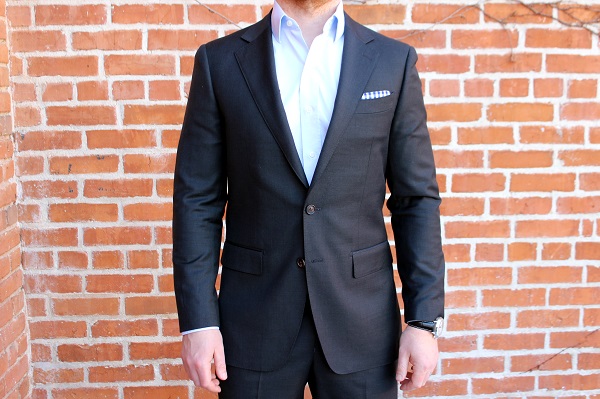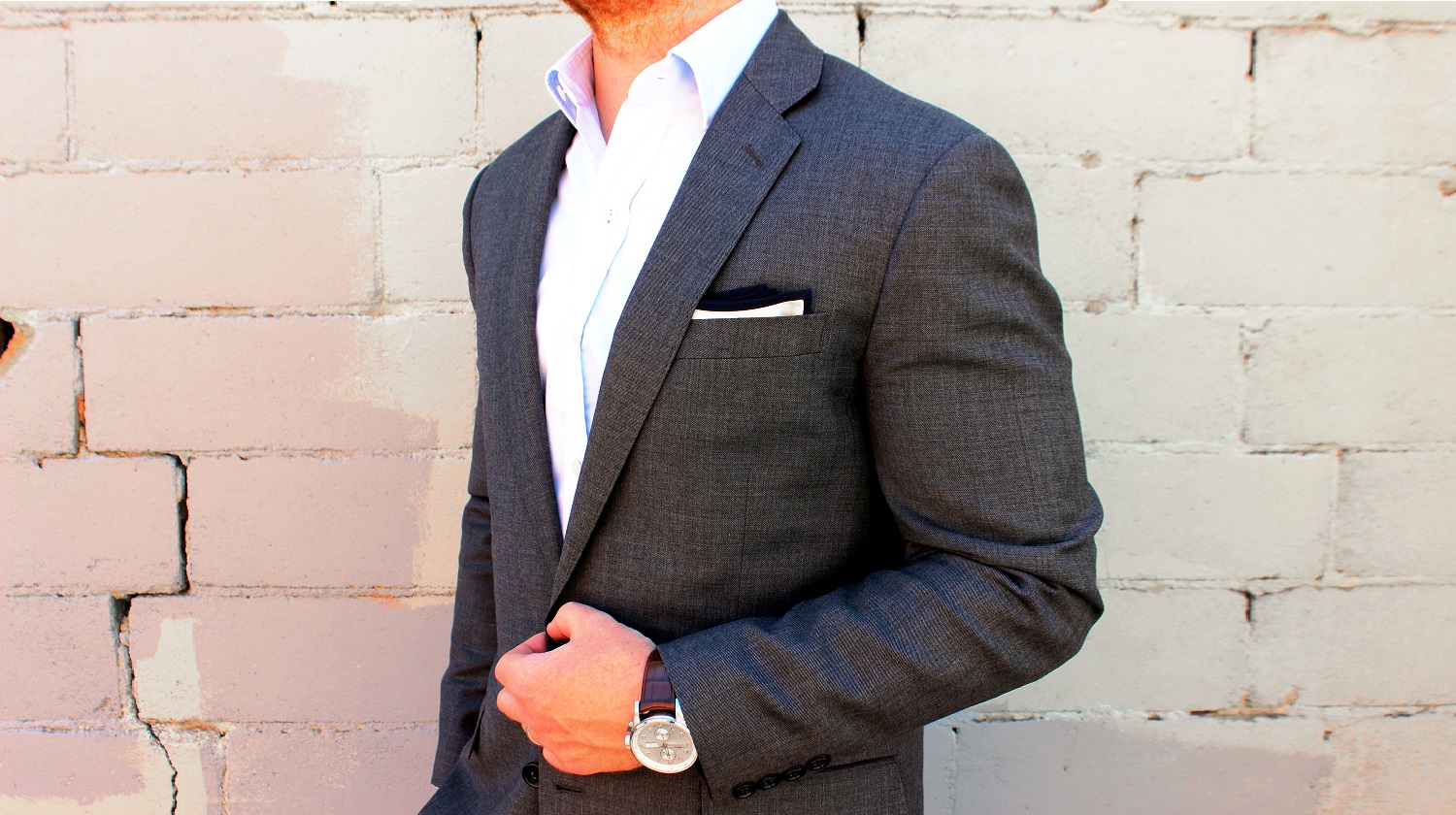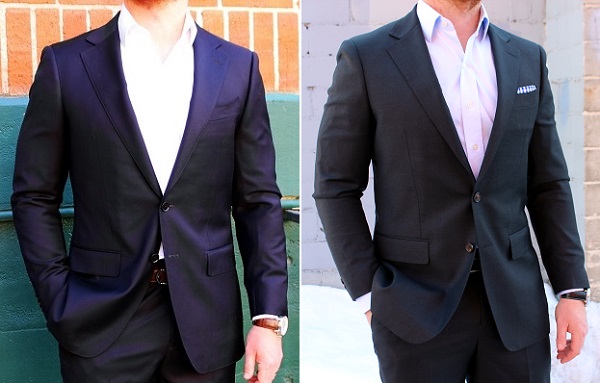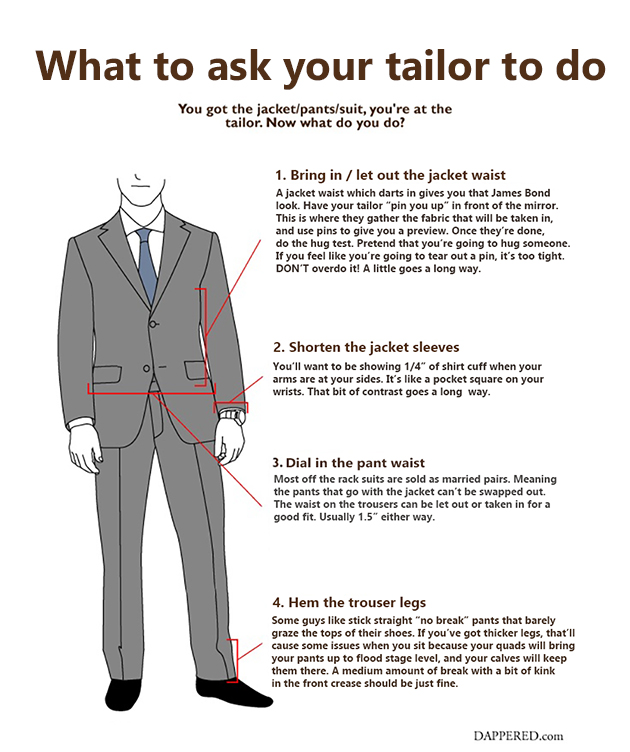Know Why You’re Buying a Suit
Are you getting married? Are you going to start interviewing for a job? Do you just like the way a suit looks? Picture yourself in the circumstance that will require you to be in a suit. What suit “fits” the situation? A suit is a tool. And knowing what tool is used for what job can go a long way.
Choose Your Color: Solid Navy or Solid Grey, in all-season Wool
Notice you get to choose a color but not a fabric. For your first suit, you’ll be getting one made out of an all season wool. (Unless this suit is to be worn at a mid-afternoon wedding at the equator in summer. Then, consider linen.) Wool is the king of fabrics. It’s durable. It breathes. It drapes nicely. It’s naturally wrinkle resistant. So, get something that’s mid to lightweight and feels decently smooth in your hands. Skip the heavy flannels, or tweeds, or chino, or linen, or blends, or (heaven forbid) synthetics. You want a basic wool.
For your first suit, pick navy or charcoal. For your second suit, get the other.
Both suits shown above are a 40R in Spier and Mackay’s contemporary fit on 5’10″/185.
For the color, navy is more style forward (you can wear lighter brown shoes with it). Charcoal is more sober and conservative (perfect for job interviews). Medium grey? That can work too. But navy or charcoal won’t let you down.
Know how often you’ll wear it
Will it be worn a few times a year? A few times a month? If you’ll be wearing it frequently (say, a few times a month) then you’ll want to go with a suit that has a half canvas construction (at least $300 and up). They’re more durable, and are almost always made with higher quality materials and better attention to detail. If it’ll be in the closet for all but a few nights a year, a fused suit (usually cheaper than half canvas) should be fine. Here’s a list of both fused and half-canvas suit brands that are worth your attention.

Like wearing suits for the heck of it? Invest in half-canvas.
Suit shown above: J. Crew’s Crosby fit.
Know the risks of Buying in Person
Buying a suit is like buying a car. There are some tremendously helpful salespeople, and there are some tremendously terrible salespeople. And some will try and pressure you into buying something they think works on you, instead of listening to what you want. Also, not everyone has access to brick and mortar locations for some of the more popular, best value brands out there (say, Suitsupply).
Know the risks of Buying Online
Shipping and returns can be a pain, and depending on the company, costly. You can’t try it on before you hand over cash. There’s no free, basic alterations (although some stores/brands offer this). Online pictures can sometimes be deceptive in terms of the true fit and color of the fabric.

“It’s my suit in a box!“
Know how sizing works
Nested Suits: These suits have what’s called a “drop”. A suit’s drop is the inch difference between the suit jacket size and the pant waist measurement. So a 40R suit with a 6″ drop comes with trousers that have a 34″ waist (40 – 6 = 34). Prioritize jacket fit. A tailor can bring in the pant waist by an inch or two if need be.
Suit Separates: You purchase a jacket and matching pants separately, and in the process, get to choose what size fits you best. This is good for guys who don’t fall within the usual “drop” zones. Say, someone with a barrel chest but a thin waist. That fella can get a 44 jacket, and a 32 pant, if he so chooses.
Custom: You get measured, they make the suit for your specs. The only option for those with extra unique proportions. I helped a pal buy a suit for his wedding once. He’s 6’0″ with a 38″ chest and, wait for it, 37″ sleeves. Dude’s got some lonnng arms for his torso size. He went with Black Lapel and the suit turned out great. But that’s not always the case with online custom suit makers, of which there are a ton. Make sure you’re familiar with their return/exchange/remake policy before diving in.
Know some tricks to figure out if it’s a good fit
Put on the jacket and lean your shoulder into a wall. Does the shoulder pad strike first? That’s not good. Does your shoulder and the pad strike at the same time? That’s good. More tricks here, and, here’s what you should prioritize in terms of what absolutely has to fit, and what can be just in the ballpark.

Not boxy. Not tight. Just right. Sleeves have been shortened here, but that’s it.
Get an extra set of trusted eyes on board
Have a well dressed pal? Do you want to look great in a suit for a significant other? Get their opinion on how the suit looks on you before leaving the store and/or taking the tags off at home and committing to the purchase. They might see something you’d otherwise miss, or, you might be overthinking something that they can then set your mind at ease about.
Know what can and cannot be adjusted by a tailor
You need to know this before setting foot in a store. A tailor can’t shave down the thickness of the shoulder pads, bring in the pants by more than an inch or two, change the width of the lapels, or lengthen the jacket (and shortening a jacket can go wrong in a hurry… best not to mess with it). BUT… here’s a few common alterations you might want done post purchase:
Common alterations many men have done post suit purchase.
Stick with the basics when it comes to design details
Don’t get flashy and weird with your first suit. Get something timeless. A single breasted, two button jacket with notch lapels that are between 2.5″ – 3.5″ wide won’t be out of style any time soon, if ever. Same goes for flat front trousers. Avoid bulky shoulder pads and lower armholes that restrict movement.
Know how to store it, and care for it, post purchase
When not in use, hang your suit jacket on a wide shouldered hanger and the pants on a decently wide (meaning not wire) pant hanger (yes, most wide shouldered hangers come with a built in pant bar). Keep it in a garment bag… a breathable one if possible. And don’t dry clean the thing with every use. In fact, dry clean as little as possible (like, if it stinks/is stained). Dry cleaning can be extremely harsh, and crummy dry cleaners can sometimes over cook a jacket, causing the fusing of the jacket to liquefy and resettle into unsightly ripples and bumps. Consider purchasing a steamer, and using that to freshen up your suit / release wrinkles when necessary.

Two button, Notch lapel, flat front pants. Pretty timeless.
Suit is by Bonobos (albeit their cheaper, discontinued “foundation” line)
TL;DR Version:
For a first suit, most will want an all season wool, navy (more stylish) or charcoal (more conservative/sober), notch lapel, two button suit with minimal shoulder padding and flat front trousers hemmed to a medium break. Whether off the rack or by way of a tailor, you’ll want the fabric to skim your frame while not restricting movement or comfort. Trim is not tight. Loose is not trim. You’ll know it when you both see and feel it. Invest in a half-canvas construction (or hell, full) if you’re going to wear it a ton. Fused should be fine for those who only wear a suit a few times a year. And whatever you do, don’t over dry clean the thing.
Also (very much) Related:
The Best Suits Under $500 – Four Brands that Deliver
Good fabrics. Good fits. From $300 – $500. Bang-for-the-buck brands for suiting up on a budget.
In Review: Spier and Mackay $348 Red Label Suits
Wedding or not, here they come. In person with Spier’s new half-canvas, all wool, $348 suit line.
20 Reasons for a guy to dress well when he doesn’t have to (or want to)
Because dressing up is getting rarer and rarer. And sometimes we plain don’t want to. Here’s 20 reasons to give it a go all the same.





